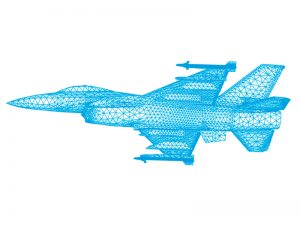One of the concerns of fighter pilots is to evade enemy radar. A new prediction method can help in the management of the radar signature of an aircraft.
A low radar signature helps fighter pilots to delay detection by enemy radars and to execute their mission effectively. To understand the radar signature of fighter aircraft, costly measurements and calculations are required. With a view to analysing how potential enemy radar systems observe Royal Netherlands Air Force F-16 fighters, the Ministry of Defence commissioned NLR in 2008 to develop a calculation method for predicting the radar signature of this type of aircraft.
To ascertain this radar signature, a mathematical model of the aircraft was drawn up. The model increases significantly in scale as the radar frequency rises. But with a smart mathematical method it is possible to calculate an F-16 signature at a radar frequency of 10 GHz. This can only be done using a computer with high calculation and memory capacity.
NLR has now completed the mathematical work required for analysing the F-16 model. The reliability of all these complex calculations has furthermore been verified in tests using real F-16s. All this mathematical work has practical applications. The models can, for instance, indicate what effect any modification of the fighter would have on its radar signature. With this project, the groundwork has also been completed for calculating the radar echo of future aircraft types.

